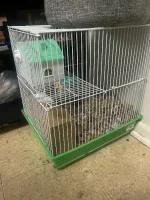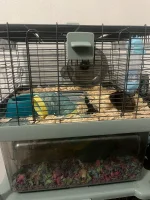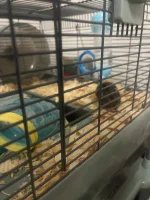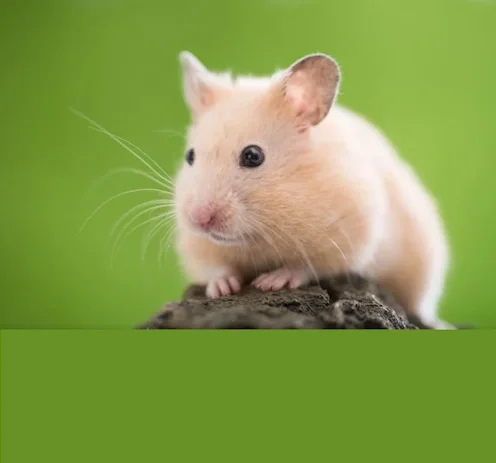I’m new to this forum, I was wondering, I have a small hamster I bought my grandson. I bought a new bigger cage for it. However I left the bedding that came with the cage. I noticed my hamster acting very strange. I asked the person if I should clean out the bedding he said no. But I’m wondering if it was used. Help not sure what to do.
Navigation
Install the app
How to install the app on iOS
Follow along with the video below to see how to install our site as a web app on your home screen.
Note: This feature may not be available in some browsers.
More options
Guest viewing is limited
- You have a limited number of page views remaining
- 2 guest views remaining
- Register now to remove this limitation
You are using an out of date browser. It may not display this or other websites correctly.
You should upgrade or use an alternative browser.
You should upgrade or use an alternative browser.
New
- Thread starter Jean
- Start date
- Messages
- 20,364
- Reaction score
- 37,415
- Points
- 1,373
Hello. So the new cage came with bedding in it already? Did contain any other items as well? It could have the scent of another hamster so it can indeed affect their behaviour. How long have you had the hamster? Usually we don't recommend a full cage clean in one go, but in some circumstances it's necessary. However if you've only had the hamster a few days that would be very stressful for them. Maybe you could let us know how long you've had the hamster now  Also which cage is it? Do you have a photo? Assume it is a dwarf hamster? Or a roborovski hamster maybe?
Also which cage is it? Do you have a photo? Assume it is a dwarf hamster? Or a roborovski hamster maybe?
- Messages
- 641
- Reaction score
- 846
- Points
- 728
Hi, welcome to the forum. Congratulations on your little hammy. If you have some photos we'd love to see him 

Thanks for your response, yes this is my first hamster, I bought it for my 8 yo grandson. But I figured he needed a bigger cage to run around in. But I asked the guy if I should clean it out he said no that he put fresh shavings and bedding. I don’t know if he did or not. The hamster was acting very strange. I wonder if I should put fresh bedding or what . I feel terrible.Hello. So the new cage came with bedding in it already? Did contain any other items as well? It could have the scent of another hamster so it can indeed affect their behaviour. How long have you had the hamster? Usually we don't recommend a full cage clean in one go, but in some circumstances it's necessary. However if you've only had the hamster a few days that would be very stressful for them. Maybe you could let us know how long you've had the hamster nowAlso which cage is it? Do you have a photo? Assume it is a dwarf hamster? Or a roborovski hamster maybe?



- Messages
- 20,364
- Reaction score
- 37,415
- Points
- 1,373
Hello. Don't worry, we have all been there with a first hamster! Our first one had two cage changes! So is the second cage on the photos, the new one? The first one definitely is risky as it's quite tall (hamsters climb and drop). It looks like there's a hamster in that first cage photo as well? But a different one?
Unfortunately the second cage is quite small as well, and his behaviour might be more to do with that, than the bedding itself. I think it's a russian dwarf hamster you have - from the second lot of photos, but it's hard to tell How big is he? About 6" long or about 3 to 4" long?
How big is he? About 6" long or about 3 to 4" long?
Ok so the second cage - is that another level underneath with a tube going down to it, where there's more bedding?
The hamster is probably quite disorientated. Firstly because any change of cage can do that anyway, and secondly he maybe doesn't have enough hiding places.
I'm sorry if this is bad news but a cage needs to be ideally on one level with extra length and depth and less height. Eg about 40" x 20" and no more than 20" high (unless you have very deep bedding);.
However there is a solution! I think you're in the US and you can get really large totes to make a bin cage there. @ilguy has more information about that - I think it's Homemart and a 200 quart bin. It's an inexpensive cage option for a hamster that is similar to a glass tank but cheaper (many people in the US use glass tanks for hamsters but it needs to be big enough). The downside to a bin cage is you need to do a bit of diy. Ie cut out the lid panel so there is only the rim left to attach to the bin, and mesh the centre part you've cut out. They just escape if there's no lid (they just pile the bedding up in one corner and climb out!).
Or you can get a 40 gallon breeder tank or 75 gallon tank (sometimes they are on sale and not too expensive) and there are lids available for those.
He maybe doesn't feel very secure about the vertical tunnel going down as he may not be able to get up again!
For now though, you could make the hamster feel more at home by adding a few things to the top part of his cage So he feels more secure.
So he feels more secure.
They need to have hideouts so they can go somewhere dark and feel secure. You can easily just make one out of cardboard - eg a tissue box or a child's shoe box. Adding a couple of cardboard tunnels would help too - eg a kitchen roll inner tube (slit it down the length so it expands or they can get stuck if their pouches are full).
Basically a cage set up needs to be able to allow them to have normal behaviours - which are digging, nesting, hoarding food, foraging for food and bedding, roaming around at night. scent marking it to make it their own. And wheel running.
So for now if you could give him a good sized house (he may be small but they build big nests), scatter some of his food each day on the bedding (eg put half in the bowl and scatter the other half) so he can enjoy foraging for it). And add a big pile of torn up strips of plain white toilet paper, near the new house. He will use this for nesting material as it's nice and soft and its also safe to use. He'll probably then make a nest in the house and feel more at home. This is all in the top half. I'm not sure the bottom half is usable for him and one reason they need one larger floor area is they are basically ground dwellers and also like to have everything accessible on the same level, to have normal behaviours.
Other things to check are - make sure his water bottle is letting water out properly - tap the spout each day to check water is coming out ok. Also make sure it's a height that isn't too low or high for him to reach.
You can also put out a tiny piece of fresh veg for him each day when you put his food out - maybe on a separate dish. That will cheer him up as they love fresh veg. But only a tiny bit no bigger than his ear! They eat very small amounts and a small piece gets eaten so won't go rotten somewhere.
Cucumber and broccoli are good to start with. At first just give it every third day until his digestion gets used to it, then after a couple of weeks it can be every day.
So I think it's maybe not the bedding but the cage generally and lack of places to go and things to do.
For some tips, have a look at the thread linked below It doesn't have to be expensive, cardboard is good for houses and tunnels.
It doesn't have to be expensive, cardboard is good for houses and tunnels.
Even though dwarf hamsters are small, they actually need just as much space as Syrian hamsters as they are so active. They also need at least 6" deep bedding so they can dig down and make burrows and bury their hoards. The more space and bedding they have - the less often they need cleaning out - you can just "spot clean" mainly.
If you've recently cleaned him out that will also affect his behaviour. They find full clean outs stressful as it removes all their scent and they feel invaded.
At the moment it is like a human sitting in a studio flat with no bed and no furniture So he won't feel very much at home.
So he won't feel very much at home.
I am sure your grandson could enjoy making a cardboard house and tunnel for the hamster. They usually need at least two weeks to settle into a cage and feel more confident and he may not be really handleable for the first few days either.

 www.thehamsterforum.com
www.thehamsterforum.com
Also have a look at some of the articles on the home page - these three could be helpful - and also the taming one

 www.thehamsterforum.com
www.thehamsterforum.com

 www.thehamsterforum.com
www.thehamsterforum.com

 www.thehamsterforum.com
www.thehamsterforum.com
Unfortunately the second cage is quite small as well, and his behaviour might be more to do with that, than the bedding itself. I think it's a russian dwarf hamster you have - from the second lot of photos, but it's hard to tell
Ok so the second cage - is that another level underneath with a tube going down to it, where there's more bedding?
The hamster is probably quite disorientated. Firstly because any change of cage can do that anyway, and secondly he maybe doesn't have enough hiding places.
I'm sorry if this is bad news but a cage needs to be ideally on one level with extra length and depth and less height. Eg about 40" x 20" and no more than 20" high (unless you have very deep bedding);.
However there is a solution! I think you're in the US and you can get really large totes to make a bin cage there. @ilguy has more information about that - I think it's Homemart and a 200 quart bin. It's an inexpensive cage option for a hamster that is similar to a glass tank but cheaper (many people in the US use glass tanks for hamsters but it needs to be big enough). The downside to a bin cage is you need to do a bit of diy. Ie cut out the lid panel so there is only the rim left to attach to the bin, and mesh the centre part you've cut out. They just escape if there's no lid (they just pile the bedding up in one corner and climb out!).
Or you can get a 40 gallon breeder tank or 75 gallon tank (sometimes they are on sale and not too expensive) and there are lids available for those.
He maybe doesn't feel very secure about the vertical tunnel going down as he may not be able to get up again!
For now though, you could make the hamster feel more at home by adding a few things to the top part of his cage
They need to have hideouts so they can go somewhere dark and feel secure. You can easily just make one out of cardboard - eg a tissue box or a child's shoe box. Adding a couple of cardboard tunnels would help too - eg a kitchen roll inner tube (slit it down the length so it expands or they can get stuck if their pouches are full).
Basically a cage set up needs to be able to allow them to have normal behaviours - which are digging, nesting, hoarding food, foraging for food and bedding, roaming around at night. scent marking it to make it their own. And wheel running.
So for now if you could give him a good sized house (he may be small but they build big nests), scatter some of his food each day on the bedding (eg put half in the bowl and scatter the other half) so he can enjoy foraging for it). And add a big pile of torn up strips of plain white toilet paper, near the new house. He will use this for nesting material as it's nice and soft and its also safe to use. He'll probably then make a nest in the house and feel more at home. This is all in the top half. I'm not sure the bottom half is usable for him and one reason they need one larger floor area is they are basically ground dwellers and also like to have everything accessible on the same level, to have normal behaviours.
Other things to check are - make sure his water bottle is letting water out properly - tap the spout each day to check water is coming out ok. Also make sure it's a height that isn't too low or high for him to reach.
You can also put out a tiny piece of fresh veg for him each day when you put his food out - maybe on a separate dish. That will cheer him up as they love fresh veg. But only a tiny bit no bigger than his ear! They eat very small amounts and a small piece gets eaten so won't go rotten somewhere.
Cucumber and broccoli are good to start with. At first just give it every third day until his digestion gets used to it, then after a couple of weeks it can be every day.
So I think it's maybe not the bedding but the cage generally and lack of places to go and things to do.
For some tips, have a look at the thread linked below
Even though dwarf hamsters are small, they actually need just as much space as Syrian hamsters as they are so active. They also need at least 6" deep bedding so they can dig down and make burrows and bury their hoards. The more space and bedding they have - the less often they need cleaning out - you can just "spot clean" mainly.
If you've recently cleaned him out that will also affect his behaviour. They find full clean outs stressful as it removes all their scent and they feel invaded.
At the moment it is like a human sitting in a studio flat with no bed and no furniture
I am sure your grandson could enjoy making a cardboard house and tunnel for the hamster. They usually need at least two weeks to settle into a cage and feel more confident and he may not be really handleable for the first few days either.

Show us your cages 2023 onwards
A new thread for 2023 to show cage set ups :) Some may have changed or be new but feel free to add your existing set up again. It's mainly so all current ones are viewable in the same place.
 www.thehamsterforum.com
www.thehamsterforum.com
Also have a look at some of the articles on the home page - these three could be helpful - and also the taming one
Hamster cage cleaning
Tips on how to clean your hamster cage and avoid causing stress to your hamster. It's best to have plenty of depth of substrate and mainly spot clean your hamster cage. Avoid disturbing your hamster's nest and hoard.
 www.thehamsterforum.com
www.thehamsterforum.com
Hamster Bedding and Substrate
Choose the best and safest litter material, bedding and substrate for your hamster. Paper based substrate is one of the safest and hamsters love it - it's nice and soft. There are other safe substrates available and this article gives...
 www.thehamsterforum.com
www.thehamsterforum.com
Enchrichment for Hamster Cages
Enriching your hamster's cage enables normal hamster behaviours and a happy healthy life, with lots of variety and comfort. Enrichment includes plenty of items in the cage to provide cover and digging opportunites. Floor tunnels and hides and...
 www.thehamsterforum.com
www.thehamsterforum.com
Last edited:
Thank you so much for all that information, I believe he is a dwarf and 3-4 inches long. Yes he is in the picture the same one and that is the new cage. I’ll see what I can do to make him more comfortable. Thanks again that was alot of information.Thanks for your response, yes this is my first hamster, I bought it for my 8 yo grandson. But I figured he needed a bigger cage to run around in. But I asked the guy if I should clean it out he said no that he put fresh shavings and bedding. I don’t know if he did or not. The hamster was acting very strange. I wonder if I should put fresh bedding or what . I feel terrible.
View attachment 10736
View attachment 10737
View attachment 10738
God bless
- Messages
- 20,364
- Reaction score
- 37,415
- Points
- 1,373
Keep us posted - we can give lots of tips  I think he will be fine where he is for now, if you manage to add some things for him as above, but he could do to be upgraded again
I think he will be fine where he is for now, if you manage to add some things for him as above, but he could do to be upgraded again  Unfortunately there is no legislation over cage sales and some things sold just aren't suitable for hamsters!
Unfortunately there is no legislation over cage sales and some things sold just aren't suitable for hamsters!
- Messages
- 132
- Reaction score
- 331
- Points
- 1,030
I got my big bin from Home Depot here in the States, it's huge and was on sale for $35. You do need to install the mesh yourself, they call it "hardware cloth" and it's sometimes in the plumbing or gardening section. Usually between $10-20 and you should get the 1/4th in or smaller.
The sides and lid can be easily cut with a box cutter to make room for the metal mesh. To keep it in place I put holes in the sides and used zip ties to secure it, then hot glued it in place. It holds a foot and a half of bedding with room for a NiteAngel wheel to sit on the surface if you taper it down. I did a post of it here a couple years ago: https://www.thehamsterforum.com/threads/henrys-bin.928/
The sides and lid can be easily cut with a box cutter to make room for the metal mesh. To keep it in place I put holes in the sides and used zip ties to secure it, then hot glued it in place. It holds a foot and a half of bedding with room for a NiteAngel wheel to sit on the surface if you taper it down. I did a post of it here a couple years ago: https://www.thehamsterforum.com/threads/henrys-bin.928/
Last edited:
- Messages
- 641
- Reaction score
- 846
- Points
- 728
Thanks for your response, yes this is my first hamster, I bought it for my 8 yo grandson. But I figured he needed a bigger cage to run around in. But I asked the guy if I should clean it out he said no that he put fresh shavings and bedding. I don’t know if he did or not. The hamster was acting very strange. I wonder if I should put fresh bedding or what . I feel terrible.
View attachment 10736
View attachment 10737
View attachment 10738
He's a little cutie
